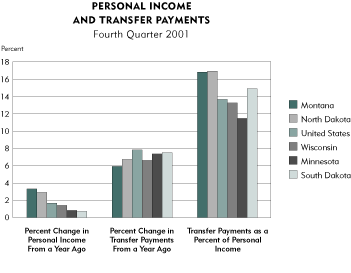Using personal income growth as a measuring stick, it appears that the slowdown in the national economy last year had a larger impact on Minnesota, South Dakota and Wisconsin than it did on North Dakota and Montana.
|
Personal income consists of income people receive from participation in production, government and business transfer payments, and government interest. Also included are interest, dividend and rental income. Personal income is measured before the deduction of personal income taxes. |
|
PERSONAL INCOME
Fourth Quarter 2001 (Millions of dollars, seasonally adjusted at annual rates) |
|
| United States | $8,633,090 |
| Minnesota | 162,915 |
| Wisconsin | 156,378 |
| Montana | 21,404 |
| South Dakota | 19,966 |
| North Dakota | 16,351 |
| Source: U.S. Bureau of Economic Analysis | |
At the national level, total state personal income* growth increased by 1.7 percent from fourth quarter 2000 to fourth quarter 2001—considerably slower than the annual average of about 6 percent from 1995 to 2000. Personal income in Montana and North Dakota grew faster than the national average, while Minnesota, South Dakota and Wisconsin all grew slower than the national average.
A key to the divergence among district states was earnings from the manufacturing sector. In Minnesota, South Dakota and Wisconsin, manufacturing earnings decreased more than 4 percent; they fell only 1 percent in Montana and rose 5 percent in North Dakota.
Furthermore, district states where personal income dropped the most also rely more heavily on manufacturing. For example, personal income earnings from manufacturing in Minnesota (14 percent) and Wisconsin (17 percent) are much higher than the national average (11 percent); in Montana and North Dakota, that figure is only 5 percent and 6 percent, respectively.
Public and private transfer payments, which include unemployment insurance benefits, generally increased at a higher rate in Minnesota, South Dakota and Wisconsin compared with Montana and North Dakota during 2001, but all district states remained below the national average of 7.8 percent.
Historically, however, transfer payments in Montana and North Dakota comprise a larger share of personal income relative to other district states. In 2001, transfer payments made up 17 percent of personal income in Montana and North Dakota but were lower in Minnesota (11 percent), Wisconsin (13 percent) and South Dakota (15 percent).

Source: U.S. Bureau of Economic Analysis

Source: U.S. Bureau of Economic Analysis
*Personal income as the sum of all U.S. states differs slightly from total U.S. personal income.





